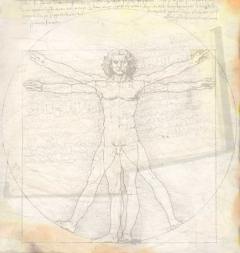|
|
 |
| makua |

|
A kahuna named Makua, whose alaka'i was my friend Lani Yamasaki, was killed in
an automobile accident on the island
of Hawaii about a year ago. Elders have been leaving a lot the last few years, many while still only
in their 60s. Anyway, Makua, like most of the wisest old folks, said things that, well, didn't make sense. That's
not right of course. It's not that those things they say don't make sense, exactly, but they make a different kind of
sense and it takes a while, even a long time, for that sense to be clear.
Makua talked about eagles, for instance. Hawaiian eagles. And what they
were called in the symbolic language - he said they were called moa (and that's how he always referred to them).
And he said that Ala Moana is sacred to the eagle. He said the reason Ala Moana was called Ala Moana was that it's really
named Ala Moa-na (and the "na" just makes the word plural).
But there aren't any Hawaiian eagles. And the place he said was sacred to them
is a very public and heavily used Honolulu beach park in front of a grassy area that used to be a dump and before that a muddy
brackish marsh.
So, I don't know how other people listen to the old folks when what they say doesn't
fit into what we know or our western- adapted thinking that helps keep jobs and pay bills and fix the car and get
the kids to school. For me, the experience is like separating my mind into two pieces, each of which suspends judgment.
One part, the everyday part, goes on mumbling the way it always does, and the other part listens and pays attention and accepts.
Today I came across an October 2000 article
in the journal Auk, a bird science journal. The title of the article is "Identification of the extinct Hawaiian
Eagle (Haliaeetus) by mtDNA sequence analysis."
So there was a Hawaiian eagle, just like Makua said.
And the eagle remains the scientists found were in a cave in a place on Maui called
Pu`u Makua - Makua's Hill. Maybe that's a coincidence. But . . . there's no such thing as coincidence in Hawaiian
thought: there're just connections you haven't experienced yet.
| a white-tailed sea eagle, the eagle - |

|
| - scientists say the Hawaiian eagle was |
|
 |
|
There's a lot of cultural knowledge that was never widely
shared and didn't find its way into books, even books written by native writers. Academics and others have
difficulty accepting as true something that can't be verified from existing written sources. I know I've said
that already, but it bears repeating. Maybe a lot of repeating.
Anyway, in Ontario, Canada there's a rock called Ekarenniondi (Huron - Wyandot - Iroquois)
and Oscotarach. It's here that the nest of the Blue Thunderbird is. It's where the Blue Thunderbird is born.
And out here in the middle of the Pacific, where the blue thunderbird Halulu lived/lives is
the place where the Blue Thunderbird comes to die so that he can then be reborn again at Ekarenniondi.
East is the sunrise, the daily rebirth of the sun, the direction of beginning. West
is the sunset, the passing into the realm of spirit, the direction of endings. The time between death and rebirth is
spent in the Underworld/World Below/Sky Below/the realm of Po.

"Large pendants found around New England include
a copper 'thunderbird' shaped gorget. This large neck ornament, from Amoskeag, New Hampshire, was probably fashioned from
a copper kettle Brasser (1978)" - www.nativetech.org/metal/pendants.html
(A great website, by the way.)
I came across some other website the other day, wish I could remember
what it's called, while I was searching for pre-Twentieth Century American Indian tin, brass, and copper ornaments.
I took a wrong turn and ended up in alienland where I saw the gorget photo put online as proof that aliens had been here because
the bird-figure's eyes weren't in his head, but were, rather, on his chest.
It's jewelry. Someone wore it, strung on a string or hide. Now, why do you think
it has holes in its chest? To string hide or other material through so it can be worn.
Sometimes . . .
. . . you just gotta smile
/.\/.\/.\./\./\./\./\./\./\./\./\./\./\./\./\./\./\./\./\./\./\./\./\./\./\./\./\./\./\./\./\./\./\./\./\./\./\./\./\.
===========================================================
more thunderbird/birdman/eagle things
The petroglyphs on stones of Moanalua Valley include several
"birdman" figures.
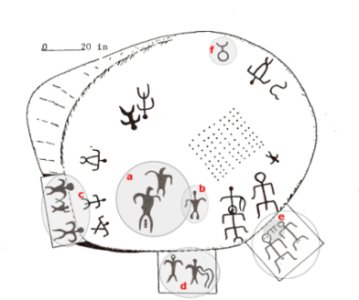
The stone's name is pohaku-ka-lua-hine because some
many years ago a grandmother (-hine) hid her grandbaby in/behind/under a hollow (lua) of the stone (pohaku).
But a long long time ago the stone was a god and it could take at least two forms. In
its rock form its name was Laupo. In its bird form its name was Laea.
Laupo: lau po, la u po, la upo. Lau po - many nights/time of darkness. La
u po - sun/day (plural prefix) nights/darkness.
La upo - sun sound of hands clapping against body.
Laea: La ea - sun/day life/sovereignty/spirit; sun erect (overhead). La 'ea -
sun noisy.
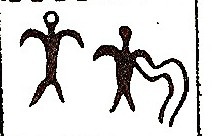
|
| d. (moanalua) |
| a birdman-like petroglyph |
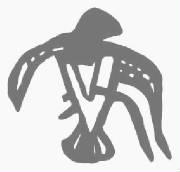
|
| in Peterborough, Ontario, Canada |
And there's the name - Moanalua. Remembering what Makua said
about moa, we get moa-na-lua - eagles' (moa-na) den/nest/cave (lua). Lua has other meanings as well - the number 2;
an equal, likeness; companion, mate; a hawaiian martial art experts in which were chiefs' guards.
We can also look at mo-ana-lua - mo'o (as dragon or as succession or as the mo'o order of
priests, or as all three. The mo'o priesthood were readers of the signs of earth, sky, and sea.)
With mo'o ana lua we get mo'o cave/star lua, all of which makes me wonder whether Moanalua
might have been kapu to ruling chiefs and their immediate family and associates, a place where, among other things, the
right of succession was confirmed via such omens as star movements.
(There's another Oahu valley that I believe was similarly kapu, although kapu to kahuna rather
than alii.)
Egads, this gets exhausting. But it's really important. Extremely important.
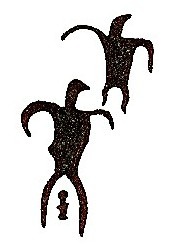
|
| a. from moanalua |
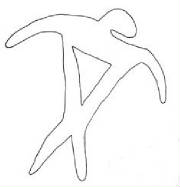
|
 |
|
|
 |
|
|
 |
|
|
|
|
I keep bumping my head. There's so much I don't
know, don't even suspect, haven't even imagined. Often the information's in a book or in a story I've
read or heard but hadn't the eyes or ears to recognize.
There's a third thunderbird in addition to Halulu and Kiwaa. It's
name is Hiapo. Kamakau mentions it in Ruling Chiefs, I forget which page but Hiapo's in the book's index.
The names of Halulu and Kiwaa both have reference to sound. So does Hiapo,
but not quite as easily discernible.
The usual and best known meaning of hiapo is "first born" or "oldest child" in
a family. But there's another way to understand hiapo. I wouldn't have noticed except that a few days before I
reread the section of Ruling Chiefs in which Kamakau mentions Hiapo, I read an article in a book of compiled articles
called Ancient Hawaiian Civilization.
The article talked about the bardic tradition in Hawaii, about how the composers
and orators of mele and chant were, as were the Celtic bards of Ireland and West Scotland, extremely well-versed in word use
- puns, double, triple, quadruple entendres, symbolism, metaphor, linked images, etc., as well as in the forms, rhythms, and
internal rhyming of the chants and meles.
Also like the Celtic bards, the Hawaiian bards were revered and respected, traveled
from court to court, and managed prodigious feats of memory. And they were members of a profession, a class called "apo."
This meaning of apo is not, at least on its face, in the dictionary.
The dictionary gives apo as "circle, circuit; to span, reach around, embrace" and "union of the molar and cheekbone with the
temporal bone." It gives 'apo as "to catch, grasp, seize and retain."
The apo makes a "circuit" of the courts he visits. His craft reaches around
people as well as to them. The union of molar etc is the facial anatomy used in speaking. And the 'apo certainly
siezes and retains words in his memory.
Hi is to flow. Together the hi and the apo speak of the traits and work
of those whose profession it was to create and memorize lore and chants and mele.
It doesn't seem, though, that first born as a meaning is erased because
there are so many other meanings within the word. I wonder whose first born Hiapo is and who/what his younger
siblings are.

Along time ago, after the deluge of Ke Kai a
Kahinalii and the arrival of Lono-Pele ma there was a chief named Kamalalawalu. You can find him mentioned in Kamakau
and in the Kanalu genealogy chant, but it's not his role in the story I'm thinking about. It's his name - Kama-lala-walu
- child-branch/fin/oblique-eight, in other words the eighth generation on a side branch of a family.
I wasn't smart enough to figure that out. A friend whose own family's genealogy
is in the Kanalu line told me because I got the wrong meaning - night hawk- branch/fin/oblique - eight/rub. So,
um, . . . what's a night hawk?
That's where I got stuck. A night hawk. Not just a night hawk, whatever
that is, but a night hawk that would have been known in Hawaii a thousand years ago.
I ran around on a horse named Google and learned that night hawk means owl.
Kama - night hawk, pueo - owl. Hmm. Doesn't seem like the whole ball of wax.
Ka - hit, strike, smite, fling; to clean, as weeds from a pond; to fish with
a pole; to snare; to curse; to murder; knee-drum beater; thigh of a bird; incoming.
Ma - faded; defeated, passed away; eye; mesh; desire.
La - sun; day, etc
Lala - as earlier on this page plus
bright and shiny
Wa - epoch, era, season, age; to make noise, roar, to talk much, to talk loudly
back and forth; space, interval, as between objects or time
Lu - to scatter, throw, as ashes; to push aside; to shake; to cast off, discard.
Walu - the number eight; to rub
I think I see the passing of one solar/steller era to another.
Then someone told me that kama/night hawk is the aukuu, the black-crowned night
heron. Oh. Well . . .
I was partial to raptors at that moment. In fact I was hearing Pueo call
every morning in the forest outside my house. It's a surprising call if you're expecting a tv owl - whooo hooo.
It doesn't call whoo. It shriek-cries like a red-tailed hawk, the sound you hear in movies shot in the US wilderness
and Indian Country.
But there are a couple of qualities of the aukuu that make it a night hawk.
It screams. It fishes. Ancient Egyptians also used a heron as their bennu bird (thunderbird). And the aukuu
has a long thin-feathered crest on its head patch that it usually carries folded down into its blue back feathers.
Upraised those crest feathers resemble the feathers on the Kukailimoku war god image.
| a bennu bird |
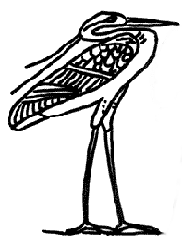
|
| note the long thin trailing head feathers |
The kolea (golden plover) is another bird associated
with Moanalua. The kolea is migratory and spends the winter in Hawaii. It's got a l-o-o-o-ng winter - August to
April-ish. While Kolea is in the Islands it exchanges its regular plumage for breeding plumage.
| kolea at moanalua |
|
|
| not dressed for courting yet |
Oh good grief! Maybe the thunderbird called
Hiapo is . . . a hiapo, the oldest/chief of the thunderbirds. That would mean, then, that Halulu is the hiapo, is Hiapo.
You know what? Phew. I gotta hop over to something else now.
<><><><><><><><><><><><><><><><><><><><><><><>
^:^:^:^:^:^:^:^:^:^:^:^:^:^:^:^:^:^:^:^:^:^:^:^:^:^:^:^:^:^:^:^:^:^

|
|
|
 |
